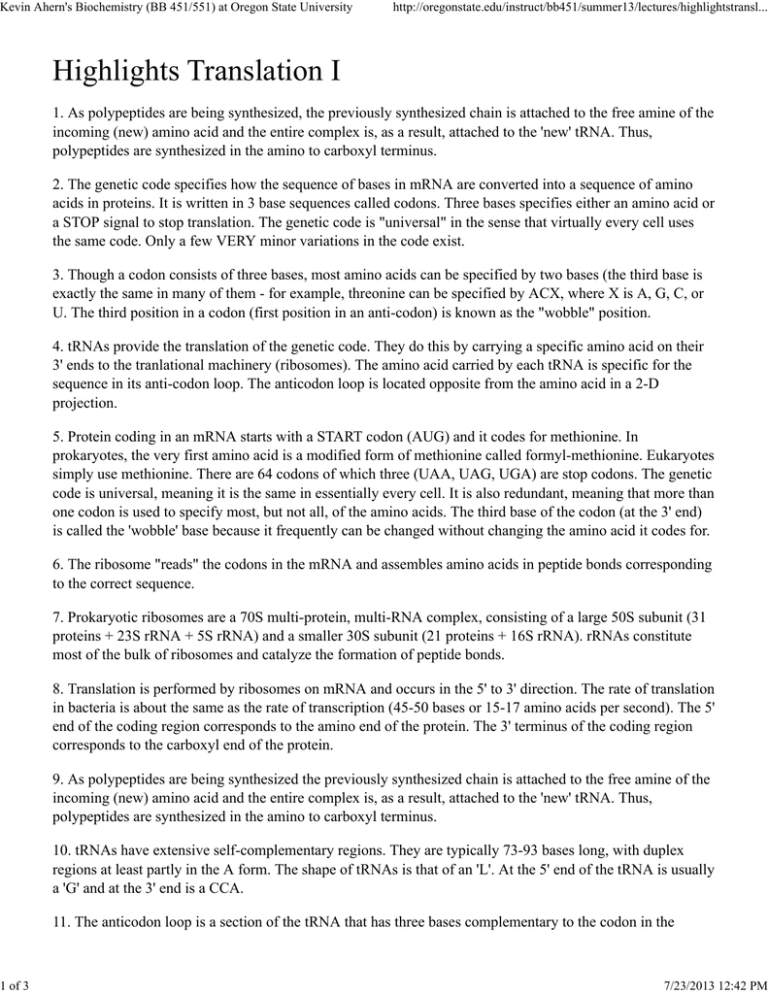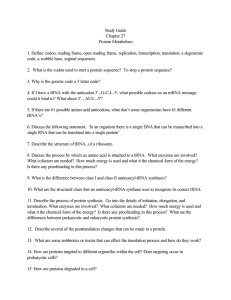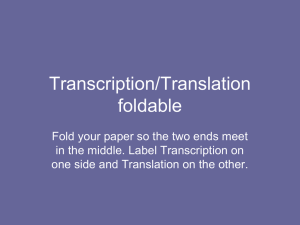Kevin Ahern's Biochemistry (BB 451/551) at Oregon State University
advertisement

Kevin Ahern's Biochemistry (BB 451/551) at Oregon State University 1 of 3 http://oregonstate.edu/instruct/bb451/summer13/lectures/highlightstransl... Highlights Translation I 1. As polypeptides are being synthesized, the previously synthesized chain is attached to the free amine of the incoming (new) amino acid and the entire complex is, as a result, attached to the 'new' tRNA. Thus, polypeptides are synthesized in the amino to carboxyl terminus. 2. The genetic code specifies how the sequence of bases in mRNA are converted into a sequence of amino acids in proteins. It is written in 3 base sequences called codons. Three bases specifies either an amino acid or a STOP signal to stop translation. The genetic code is "universal" in the sense that virtually every cell uses the same code. Only a few VERY minor variations in the code exist. 3. Though a codon consists of three bases, most amino acids can be specified by two bases (the third base is exactly the same in many of them - for example, threonine can be specified by ACX, where X is A, G, C, or U. The third position in a codon (first position in an anti-codon) is known as the "wobble" position. 4. tRNAs provide the translation of the genetic code. They do this by carrying a specific amino acid on their 3' ends to the tranlational machinery (ribosomes). The amino acid carried by each tRNA is specific for the sequence in its anti-codon loop. The anticodon loop is located opposite from the amino acid in a 2-D projection. 5. Protein coding in an mRNA starts with a START codon (AUG) and it codes for methionine. In prokaryotes, the very first amino acid is a modified form of methionine called formyl-methionine. Eukaryotes simply use methionine. There are 64 codons of which three (UAA, UAG, UGA) are stop codons. The genetic code is universal, meaning it is the same in essentially every cell. It is also redundant, meaning that more than one codon is used to specify most, but not all, of the amino acids. The third base of the codon (at the 3' end) is called the 'wobble' base because it frequently can be changed without changing the amino acid it codes for. 6. The ribosome "reads" the codons in the mRNA and assembles amino acids in peptide bonds corresponding to the correct sequence. 7. Prokaryotic ribosomes are a 70S multi-protein, multi-RNA complex, consisting of a large 50S subunit (31 proteins + 23S rRNA + 5S rRNA) and a smaller 30S subunit (21 proteins + 16S rRNA). rRNAs constitute most of the bulk of ribosomes and catalyze the formation of peptide bonds. 8. Translation is performed by ribosomes on mRNA and occurs in the 5' to 3' direction. The rate of translation in bacteria is about the same as the rate of transcription (45-50 bases or 15-17 amino acids per second). The 5' end of the coding region corresponds to the amino end of the protein. The 3' terminus of the coding region corresponds to the carboxyl end of the protein. 9. As polypeptides are being synthesized the previously synthesized chain is attached to the free amine of the incoming (new) amino acid and the entire complex is, as a result, attached to the 'new' tRNA. Thus, polypeptides are synthesized in the amino to carboxyl terminus. 10. tRNAs have extensive self-complementary regions. They are typically 73-93 bases long, with duplex regions at least partly in the A form. The shape of tRNAs is that of an 'L'. At the 5' end of the tRNA is usually a 'G' and at the 3' end is a CCA. 11. The anticodon loop is a section of the tRNA that has three bases complementary to the codon in the 7/23/2013 12:42 PM Kevin Ahern's Biochemistry (BB 451/551) at Oregon State University 2 of 3 http://oregonstate.edu/instruct/bb451/summer13/lectures/highlightstransl... mRNA. tRNAs provide the translation function between nucleic acid sequence and amino acids. The anticodon loop frequently contains the inosine base. The base at the 3' end of the codon of the mRNA (corresponds to the base at the 5' end of the anticodon in the tRNA) is called the wobble base because it is less important for specifying the amino acid to be inserted than the first two bases. 12. Enzymes that catalyze the linkage of amino acids to tRNA's 3' or 2' ends are called aminoacyltRNA-synthetases. There are 20 of these enzymes - one for each amino acid. Amino acids are linked to tRNAs by ester bonds between the carboxyl group of the amino acid and either the 2' or 3' hydroxyl of the ribose of the terminal adenosine residue of the tRNA. The ester bonds are extremely unstable in water and must be protected from it. Aminoacyl-tRNA synthetases have the ability to recognize and correct errors in joining of amino acids to tRNAs. For example, if one puts the wrong amino acid on the end of a tRNA and then adds an appropriate aminoacyl-tRNA synthetase, the amino acid is readily removed. Two regions of aminoacyl-tRNA synthetases are important for editing - called the acylation site (also called the activation site) and the editing site. 13. There are two classes of amino acid tRNA synthetases. They differ in the way they bind tRNAs and in which hydroxyl of the ribose ring they attach the amino acid to. Class I enzymes attach the amino acid to the hydroxyl on carbon #2. Class II enzymes attach the amino acid to the hydroxyl on carbon #3. Note that the amino acid-tRNA link is very unstable in water and must be protected from it. 14. Base pairings in RNA are slightly different than in DNA. For example, G-U base pairs are not unstable. In addition, as will be seen later, I can pair with C,U, or A. 15. Ribosomes have three sites for binding/holding/releasing tRNAs. They are called the A,P, and E sites, corresonding to the order in which tRNAs move through them (except for the very first one). 16. mRNAs are longer than necessary to simply code for protein. mRNAs also carry information about where to start translation. In prokaryotes, this is accomplished by the Shine-Dalgarno sequence which is located adjacent to the initiating AUG codon. The AUG sequence establishes the "reading frame" of a sequence specifies which three base groupings will be used in translation. The Shine-Dalgarno sequence is complementary to a sequence in the 16S rRNA and serves to help align the ribosome with the start site for translation in prokaryotes. Eukaryotes use a different strategy. 17. In prokaryotes, the first amino acid incorporated into a protein is a formylated form of methionine called fMet. The formyl group is put onto methionine after it is in the tRNA by a transformylase enzyme. Formylation of methionine in prokaryotes protects the otherwise free amino end from reacting intramolecularly and terminating transcription. 18. Peptides exit the ribosome as they are being synthesized via a tunnel in the structure. 19. Ribosomes have three sites for binding/holding/releasing tRNAs. They are called the A,P, and E sites, corresonding to the order in which tRNAs move through them (except for the very first one). 20. Initiation of protein synthesis starts with binding of IF1 and IF3 to the 30S ribosomal unit. 21. IF2 (when bound to GTP) acts to carry the Met-tRNAf to the P site of the 30S subunit and base pairs it with the AUG start codon. IF3 departs in the process. The complex of mRNA, IF1, IF2, and Met-tRNAf is called the 30S initiation complex. 7/23/2013 12:42 PM Kevin Ahern's Biochemistry (BB 451/551) at Oregon State University http://oregonstate.edu/instruct/bb451/summer13/lectures/highlightstransl... 22. Hydrolysis of the GTP in IF2 results in release of the IF2 and IF1 from the initiation complex. That, coupled with binding of the 50S subunit yields the 70S initiation complex with Met-tRNAf in the P site and the A and E sites open. 23. The process of elongation begins on the 70S initiation complex. EF-Tu (a G protein coupled to GTP) carries a charged tRNA to the A site of the complex. If the tRNA anti-codon base pairs properly with the codon in the mRNA, it stays matched with the codon and GTP is hydrolyzed on EF-Tu and EF-TuGDP is released. If the tRNA anti-codon does not form a stable base pairing with the complex, the entired charged tRNA-EF-Tu-GTP complex dissociates. 24. Next, the peptide group on the tRNA in the P site is transferred and covalently linked via peptide bond to the amino acid on the tRNA in the A site. This reaction is catalyzed by an enzymatic activity called peptidyltransferase - a ribozyme activity of the 23S rRNA in the 50S subunit. 25. The tRNA in the A site along with the peptide it is covalently attached to is transferred to the P stie as the "empty" tRNA in the P site is moved to the E site. EF-G-GTP is involved in the process and GTP is hydrolyzed in the process. EF-G-GTP has a similarity to the tRNAaminoacid-EF-Tu-GTP complex and may act to displace it. 26. As the old tRNA is released from the E site, the empty A site accepts the aminoacyl tRNA corresponding to the next codon. The net result of one turn of this cycle is that the polypeptide has grown by one amino acid residue and the ribosome has moved along the mRNA by three nucleotide residues. The process is repeated until a termination signal is reached. 27. The process of translation termination begins when a stop codon appears in the A site of the ribosome. Termination of translation requires action of release factors (RF1, RF2). RF-1 and RF-2 carry water to the A site.The peptidyl transferase transfers the polypeptide on the tRNA in the P site to water, thus releasing the completed polypeptide from the ribosome. Yes, that is a lot of information - I'll repeat a bit of it in the next lecture to make sure you get it down :-) 3 of 3 7/23/2013 12:42 PM




